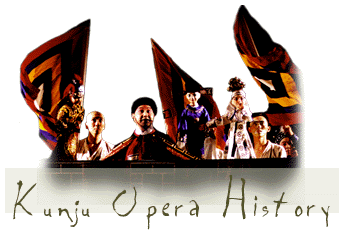
 |

Kunju opera has made its leisurely way through 600 years of Chinese history. This style of opera originated in the fourteenth century at Kunshan, in today's Zhejiang Province, when a musician named Gujian took popular songs and created the earliest Kunju. One derivation of the name of the style is from "Kunshan aria." Because of its elegant music and poetic style of writing, Kunju found favor with the literati and influential political leaders. In the middle of the sixteenth century, the Kunju music was formulated by an influential musician named Wei Liangfu, with the intent of further refining the Kunshan aria. The first true Kunju opera, Huanshi Ji (The Tale of Washing Silk), written in the early sixteenth century, adopted the style of the Kunshan aria. Subsequent works in the Kunju opera repertory include Kong Shanren's The Peach Blossom Fan, Hong Sheng's The Palace of Eternal Youth, and Tang Xianzu's The Peony Pavilion.
Few people are immune to the charms of Kunju opera. It was popular with audiences from the beginning. The Kunju style laid the foundations for what are thought of as the special characteristics of Chinese opera: its elaborate symbolism and stylized form. Performers express complex actions and settings with the simplest means, often with only a table and two chairs. For example, the story of Huansha Ji (The Tale of Washing Silk) is about a springtime hunt in the woods by the emperor. Instead of using props, the actors use movement to express the acts of riding and sailing. Thus, the Kunju style stimulates the audience's imaginative re-creation of the plot-a spirit of imagination that lies at the heart of Chinese opera.
There were two different kinds of Kunju performing troupes: the public, professional company and the private troupe supported by wealthy patrons. The public Kunju troupes usually performed as part of religious observances or to entertain people at festivals. The bamboo or earthen stages for these performances were usually built at plazas or temples; sometimes they were set up by rivers, so the audience could enjoy the play from the decks of boats. The water-side setting allowed for more efficient vocal projection-a neat solution to a familiar problem in the time before electric amplification. Currently, one such stage exists at the Opera Museum of Suzhou; its design includes a sound enhancing body of water beneath the playing area.
Festival presentations of specific plays were typically geared to some aspect of the people's lives. For example, the "Picking Lotus" scene from Huansha Ji (The Tale of Washing Silk) was usually performed in summer, "Appreciate Autumn" from Piop Ji (The Tale of the lute) in the fall, The Legend of the White Snake for the Dragon Boat Festival, and The Palace of Eternal Youth for the July festival. One special piece known as The Silkworm Cocooning Play was staged in springtime; while the silkworm farmers toiled to gather the valuable coccoons, young lovers would meet at the theater.
The other kind of Kunju troupe was sponsored privately by rich families and performed in-house for the family and guests. In general, the master of the house bought youngsters to train them as skillful Kunju actors. Their only duty was to entertain their master on all kinds of occasions, including weddings, funerals, and banquets. Kunju played an important role at celebratory banquets, not only in entertaining the guests, but also in displaying the prosperity of the master. Kunju induced an atmosphere of aesthetic refinement, bringing together the enjoyment of poetry, movement, music, and not incidentally , fine food and drink. Many of the masters who cultivated Kunju troupes were talented dramatists, and their plays were usually performed by their own troupes.
The new play thus became a feature of the private troupe. A master might also display his wealth by means of elaborate scenery and luxurious props. A family might combine spectacular lights and decor to create a pageant-like celebration. In late nineteenth century Shanghai, competition among Kunju companies built to a veritable war of lights and special effects. Public professional Kunju troupes might also be invited to play in private homes. A special kind of curtain call, called canchag, developed for these occasions. Prior to the performance, all the performers would stand on-stage to express their gratitude to the audience and forge a bond between actors and audience. Following the canchang, a VIP-the master, the honoree, or the eldest guest-would consult a menu of operas and scenes in which the troupe excelled and select the evening's fare. Ordering the plays or a special occasion such as a birthday or wedding was an art in itself. One had to be quite familiar with he stories of the plays to avoid any embarrassing situation, such as having the story conflict with the special occasions. In general, the troupe would perform some good-luck play as the opening.
Over the centuries, the graceful, elegant form of Kunju opera experienced ups and downs of popularity. Historical events also conspired to disrupt the continuity of Kunju. In the middle of the nineteenth century, political uprisings devastated the region in which Kunju was most popular. The style also suffered from dilution, when it was mixed in performance with other types of Chinese opera. It became the norm to perform traditional plays only in excerpts.
More recently, the Cultural Revolution (1966-76) brought the cultivation of most traditional forms of Chinese art to a halt. Kunju and other styles of Chinese opera gave way to evening-length works on revolutionary themes, such as those championed by Jian Qing, the wife of Mas Zedon. Today, only six troupes perform the Kunju repertory, mostly in excerpts. The saving grace for Kunju opera has been its basis in well-documented literary works and its status as the only traditional form of Chinese opera that is musically notated. The loss of some kunju works and the relative scarcity of accomplished kunju performers can not diminish the cultural value of the genre. It is hoped that this production of The Peony Pavilion, with its subsequent tour, will revive interest in the style on the part of both audiences an performers, and reveal the brilliant performing art of Kunju opera to the world.
Lu Ertin and Fang Jiaji
http://www.lincolncenter.org/toc.htm (2003)